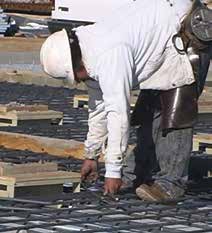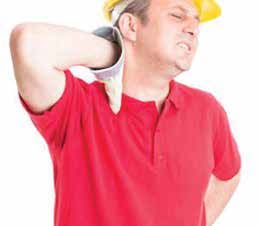Ergonomics is the way you use your body to work and fitting the job or task to you to reduce your risk of injury. The goal of ergonomics is to reduce the risk of soft tissue injuries. These injuries typically develop slowly over time and involve nerves, muscles, tendons, joints and ligaments. Examples of these injuries include low back strain, carpal tunnel syndrome, and tendonitis.
Importance of Ergonomics in Excavation Safety
Ergonomics helps to ensure you do not physically overexert yourself in the workplace. Reducing this stress on your body eliminates many injuries associated with overuse of muscles, awkward positions, and repetitive motions.
Soft Tissue Injuries (STIs)
Soft tissue injuries (STIs) may occur from activity at home, during work or recreational activity. These injuries may be the result of a single incident (such as a sudden fall, jerk, or blow to the body), or as a result of repeated overuse (such as shoveling or raking soil, tightening bolts, or machinery operation). The result can be serious damage and pain.
These injuries often start out minor, such as a muscle pull, but become much more serious if you continue to perform the task which originally triggered the injury without getting proper treatment. If not given opportunity to heal, these injuries can become chronic, which means they will stay with you for a long time. There have been cases where injuries have become so serious that it becomes painful to perform simple tasks such as walking or holding a pen or pencil.
The human body is like a machine with limits that vary from model to model. We do not come with an instruction manual, so we have to depend on the feedback our body gives us for self-maintenance and care. The wisdom we use in applying the feedback received determines how resistant our bodies will be to failure. We have some individual control over most of these issues such as our daily decisions on and off the job which impact both the frequency and seriousness of STIs.

The Risks of STIs and How You Can Prevent Them
There are 5 common ergonomic hazards that may occur as part of work activities. One of these hazards performed over a long time can cause a problem, but activities with more than one hazard can increase physical discomfort even more.
• REPETITION involves doing the same task repeatedly that uses the same muscles over and over. Repeating the same motion too often can cause wear and tear on your joints. STIs can develop if you do not rest and allow time for your body to heal. Take control over the motions you make and how often you make them. Reduce repetitive motion hazards by:
- Taking stretch breaks. If done properly, stretching increases flexibility which directly translates into reduced risk of injury. A muscle/tendon group with a greater range of motion passively will be less likely to experience tears when used actively.
- Spreading your repetitive tasks throughout the day.
- Moving your muscles in opposite directions or different ways to stay balanced.

• HIGH FORCE uses high muscle power during activities such as heavy lifting, pushing items or gripping tools. Moving heavy objects is an everyday activity that can cause STIs. The weight of an object can damage the disks in your spine or strain the muscles in your back and shoulders. Th is includes lifting, carrying, and placing heavy objects. Gripping heavy objects or applying pressure to a tool with your hands can also cause STIs. Over time, these activities can strain the muscles in your hands and arms as well as the tendons that attach the muscles to bones.
- Examine alternatives to moving heavy objects. Employ tools such as hand trucks, carts or other mechanical assistance, or get a lifting partner.
- If you must lift a heavy object, keep the load as close to your center of gravity as possible. Plan the route prior to starting to avoid twisting.
- Prevent these injuries by increasing your grip strength. Three ways to do this are: keeping your wrists straight, using two hands, and making sure your gloves fit well.
• AWKWARD POSTURES involves working with your body held in a poor position for a long time. Awkward positions stress the muscles and joints. STIs can occur if you work in these positions too often or for long periods of time. Simple fixes that can reduce or eliminate the amount of time you need to spend in those positions include:
- Stand on platforms that bring your work closer to you
- Tilt or rotate your work to a better position.
- Bring items closer within your reach.
- Change the height of your workstation or display.
- Take breaks.

• CONTACT STRESS occurs when pressure from an object pushes on soft body tissues. Individuals who work with hand tools that dig into the palms of their hands or the sides of their fingers should be aware of the potential for contact stress. Examples include extended use of pliers that are not padded and put pressure in the palm of the hand and use of tools with finger grooves in the sides of handles that press into your fingers. Practical solutions to guard against contact stress related injuries include:
- Wearing padded gloves.
- Selecting hand tools that conform to the geometry of the hands.
- Taking micro-breaks.
+Initiating daily stretching.
• HAND-ARM VIBRATION is a vibration that enters the body from a power tools or equipment. STIs are caused when the vibration is transferred into your arms and hands. Enough vibration exposure can result in the nerves and blood vessels in your hands and arms becoming damaged. These precautions help to reduce vibration:
- Using low vibration tools.
- Maintaining tools will usually help complete jobs quicker and reduce your risk to vibration exposure.
- Using anti-vibration gloves or tool wraps.
- Keeping hands warm to allow good blood flow and prevent tight gripping which can increase risks of vibration.
There are many tasks in our workplace that subject our bodies to unhealthy physical stress. Ergonomic practices reduce workplace injuries by helping to identify these dangerous tasks and then redesigning the way they are done. On average, each of us will experience at least one work-related STI during our lives. STIs can become chronic, meaning their symptoms won’t go away, and they can result in lost workdays, surgery or even permanent disability.
Michael Kay Carter is Manager of Safety Operations for Generation East with the Tennessee Valley Authority. He currently serves as the Administrator of the American Society of Safety Professionals Utilities Practice Specialty. He can be reached at mkcarter@tva.gov.



Comments